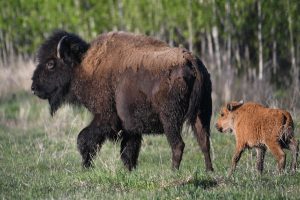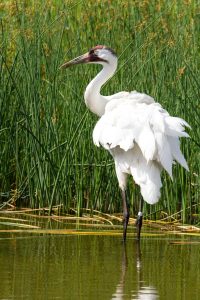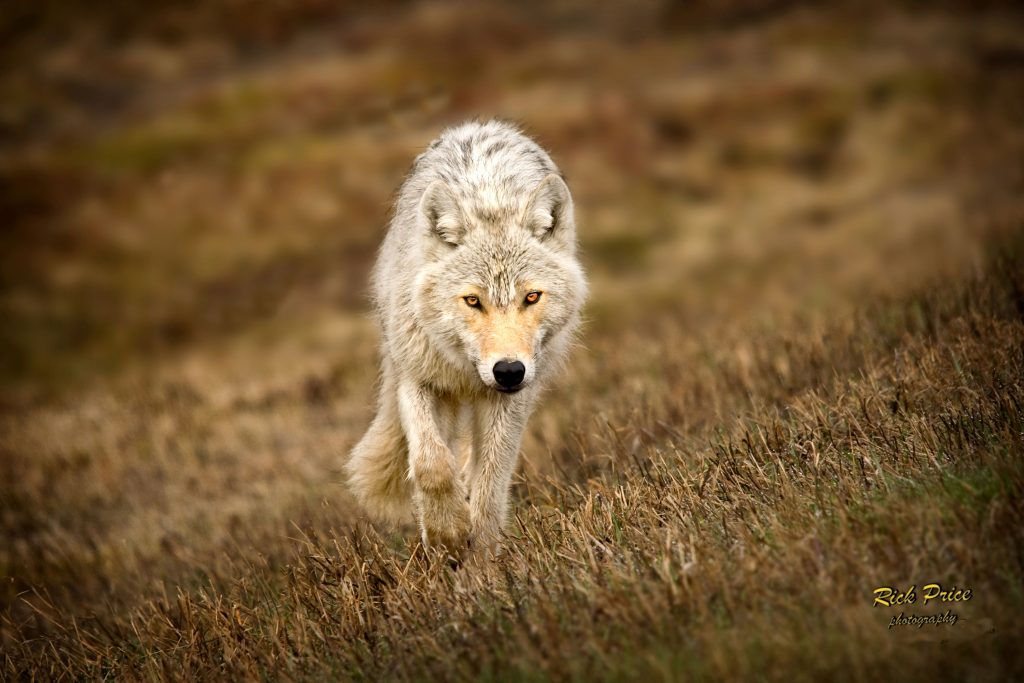Delta Dawn with the Wolves of Wood Buffalo National Park
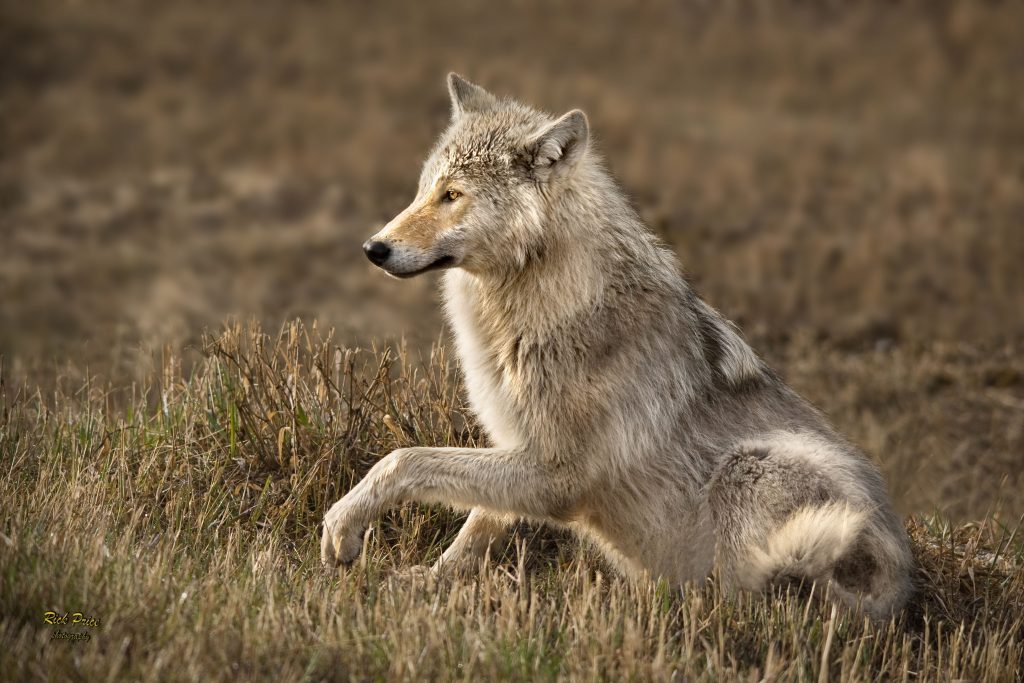
BY ERIN MCCLOSKEY
I waited five days and 50 years to see a wild wolf. Despite being a lifelong advocate for sound, humane wolf management and conservation in Canada and even having written a book about wolves1, I had never seen one in the wild. I have had fleeting glimpses of unidentified large canids in the Rockies, but no real confirmed wild wolf sighting. But as I sat crouched in the early hours of a June morning in a remote meadow within Wood Buffalo National Park (WBNP), the moment had come. And after five nights of waiting for this moment, it had come to me so generously that I was unsure if I was not still asleep in my tent, dreaming.
My arrival to this meadow came by invitation from Lu Carbyn, whose research of wolf-bison dynamics in WBNP began in 1979 and spanned 30 years. He has written countless research papers as well as Buffalo Wolf, for which he was awarded the Canadian Geographic Society’s Best Wildlife Book of the Year. Still actively writing about the park, Lu organized a revisit of his research area this past spring with his colleague, Doug Smith, the senior biologist who headed the reintroduction of wolves to Yellowstone National Park, and two WBNP bison researchers. When he invited me to tag along, with a promise to see a wolf, I could not decline!
A Unique Predator-Prey Dynamic
WBNP was established in 1922 to protect what remained of Canada’s wood bison after overhunting reduced the species almost to extinction. With the myriad sedge meadows and lowlands associated with the Peace-Athabasca Delta, the park was an ideal refuge. Today, exactly 100 years later, the park supports a population of approximately 3,000 bison, which coexist alongside their natural predator, the wolf. The core range of WBNP is quite possibly the only place where bison are wolves’ primary prey.2 It is a rare and uninterrupted interrelationship between North America’s largest predator and largest prey species.
Yellowstone National Park provides an interesting contrast.3 Plains bison were re-established in Yellowstone in 1872 from a herd of 23 and they number several thousand today. Wolves were reintroduced in 1995. The wolves primarily prey on elk, followed by mule and white-tailed deer, and only occasionally bison (though bison calves are taken in summer). In WBNP, elk are absent, deer populations are relatively low, and moose are present but widely scattered throughout the forest. Therefore, the large bison herds in the park present the most reliable and easy-to-find source of food for wolves. By necessity, WBNP wolves have developed the hunting skills and the pack coordination needed to successfully take down mature bison, which is no mean feat given these animals can weigh over 1,000 kg.
In most places where bison exist today, wolves are hunted, trapped, actively culled with poisons, or have been exterminated. In WBNP, wolves are killed by Indigenous trappers. Bison harvest is not permitted but co-management could introduce bison hunting, potentially even ranching. Hopefully, some area of the park will be preserved as the one place in Canada where the wolf-bison system can be unmolested by human harvest.
Treasured Refuge
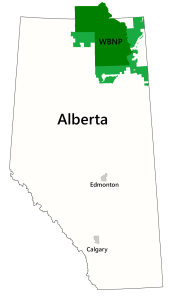
Wood Buffalo National Park is surrounded by an interconnected system of provincial parks, collectively forming the world’s largest boreal protected area, encompassing almost 70,000 km2.
In addition to the unique bison-wolf dynamics, WBNP has a variety of other valuable ecological attributes. It is Canada’s largest national park — read intact ecosystem — with an area of 44,807 km2 (by comparison, Jasper is 10,878 km2 and Banff is 6,641 km2). Its vast size and remoteness make this park an invaluable conservation area. Moreover, in recent decades conservation groups, local Indigenous communities, and local industrial players have led efforts to establish new provincial wildland parks adjacent to WBNP. Today, WBNP serves as the ecological heart of the world’s largest boreal protected area, encompassing almost 70,000 km2 — more than twice the size of Vancouver Island.
The park is a nesting and staging area for great concentrations of migratory waterfowl from all four North American flyways. When whooping cranes were pushed to the brink of extinction in the early 20th century, WBNP served as the nesting ground for the last remaining birds. Fortunately, through intensive ongoing conservation efforts, whooping cranes have slowly recovered. This is one of the world’s most celebrated conservation accomplishments. WBNP still serves as the nesting grounds for the main whooping crane population, which now numbers over 500 individuals.4 Moreover, surplus eggs from WBNP birds have been used to start a new flock that nests in Wisconsin and winters in the southeast United States, as well as a couple of non-migratory flocks.
A key feature of WBNP is the Peace-Athabasca Delta, most of which lies is within the park. At 3,900 km2, this is the largest freshwater inland river delta in North America, and one of the world’s largest. In 1982 it was designated a Ramsar site (Wetland of International Significance). The park also features extensive (370 km2) salt flats, the remnants of a sea that once covered this land hundreds of millions of years ago.
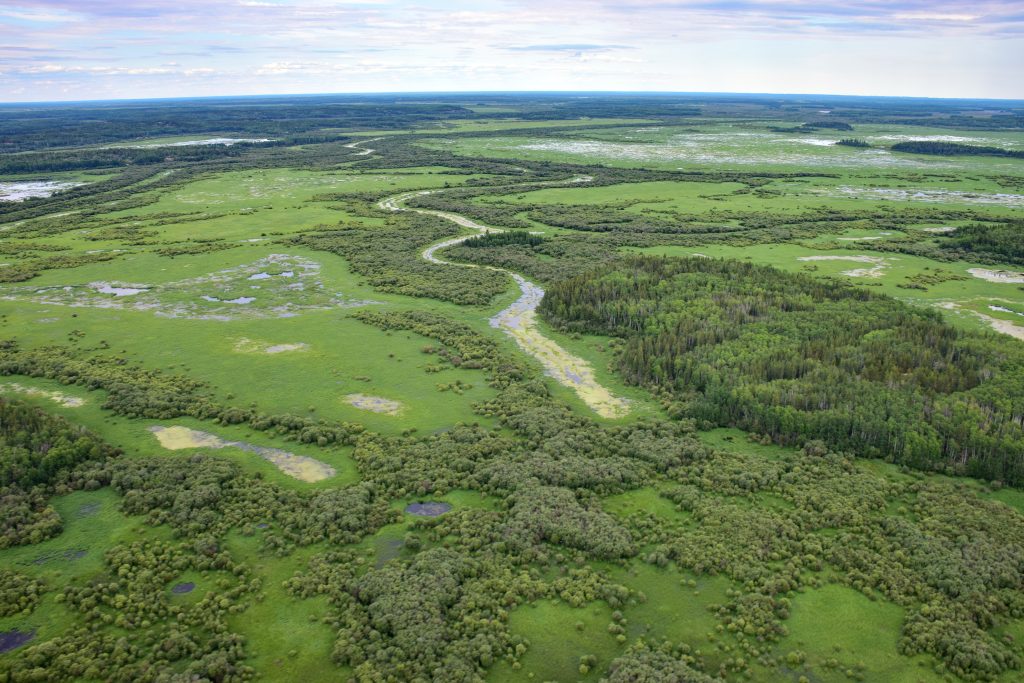
The Peace-Athabasca Delta is a distinctive feature of WBNP. Within the delta, minor differences in elevation create a mosaic of lakes, marshes, wet meadows, shrublands, and islands of forest. Robert Belanger
The distinctive karst topography within the park creates karst caves that are used as hibernacula by snakes and bats. WBNP hosts the northernmost hibernaculum of red-sided garter snakes on the continent, as well as an underground karst cave hibernaculum of endangered little brown myotis, northern myotis, and big brown bats. WBNP is also summer habitat for three species of tree bats: the silver-haired bat, hoary bat, and eastern red bat. All these bats benefit from night skies unpolluted by human light sources; in 2013 the Royal Astronomical Society of Canada in named the park as the largest Dark Sky Preserve in Canada.
A Park Under Threat
In 1983, WBNP was declared a UNESCO World Heritage Site. But despite the many things to celebrate in WBNP, there are seemingly just as many threats. In 2020, UNESCO assessed the park’s State and Trend to be “high concern and deteriorating.”5 The drying of the delta because of climate change is a major problem. In addition, there are ever-expanding upstream developments, including the W.A.C. Bennett and Site C dams in B.C. and contamination of ground and surface water from nearby oilsands mines. UNESCO has currently designated this site “significant concern” with risk of being downgraded to “in danger”; if so, it would be one of only two sites in a G7 country to be given this designation. The other current 52 sites on this list are there owing to war or civil unrest.
We must do all we can to mitigate and remove the threats to this incredible part of our province. For now, allow me to bring you back into the park with my story. To access this remote national park, which receives only a few hundred tourists per year on the Alberta side, we flew in a small commuter charter plane from Fort McMurray to Fort Chipewyan. This community is only accessible by vehicle in winter when a temporary ice road traverses the myriad waterways in the region.
Exploring the Sweetgrass Meadows
We hired a local guide to speedboat us for three hours up the Peace River and drop us at Sweetgrass Landing. From there we made our way along an overgrown path leading to the warden station at the shore of Lake Claire. This was one of Lu’s base camps when he was conducting his early field research, and the historic bison corrals still stand here from when nearly 7,000 plains bison were shipped in from Wainwright in the 1920s.
We arrived to find a herd of bison resting, grazing, and wallowing in the meadow surrounding the station. It was a large herd, over 50 by rough estimate, with lots of cows and calves. The meadow was extensively flooded, with the shores of Lake Claire reaching almost to the cabin. Where Lu once observed bison and wolves running across the fields, we found ourselves paddling canoes. The shoreline’s abundant waterfowl, including avocets and sandhill cranes, looked like they were at an overcrowded beach party.
After nearly a week of hiking and canoeing throughout the area, we had seen bison daily, a bear on day one that kept us vigilant for his return all week, and what I would call “countless” birds (the birders in the group counted 82 species including nine warblers). Wolves, however, we had neither seen nor heard, even though we had found plenty of signs or their presence — fur, scat, tracks.
I retired to my tent on the fifth evening and managed to doze off to sleep despite the light of the northern June evening, the hoofing and snorting of passing bison, the continuous singing of forest and shorebirds whose dusk and dawn chorus merge in the brief interval of nighttime, and the subconscious concern about a potential return visit from our campsite bear. In my semi-lucid state, I became aware of a heightened pounding of bison hooves. Then I heard Doug call out to me from his neighbouring tent. I was worried we were about to be stampeded by a herd of bison! Instead, Doug said: “Wolves!”
Sunrise Staredown
My head shot out of my tent, but my sleepy eyes were taking their time to focus in the dim 3 a.m. light. Within the hoof-beaten dust clouds I could make out the silhouettes of seven wolves milling around a defensively poised herd of about a dozen bison. Doug called me over, offering his binoculars while he went to the cabin to get Lu. There he left me, crouched in this meadow, peering through the binoculars of one of the world’s top wolf researchers. Surely, these have viewed more wolves than most any other binoculars on the planet!
My eyes were graced with a moment of clarity as I watched the action of this wildlife saga slow to a pause. The wolves had stopped their pursuit and were laying low, watching the bison for the next opportunity to resume the hunt. My breath also slowed as all went quiet and a single large, pale grey wolf rose while looking directly at me. And then she began walking calmly and intently towards me. When she didn’t stop walking, I began counting her paces: ten, eleven, twelve… I reminded myself that wolves do not attack people as I continued counting: eighteen, nineteen, twenty paces. Then she stopped. She must have been only another twenty paces from potentially reaching me, but stood still to stare at me while I stared back.
As the just-risen sun cast golden morning light, I could see her shaggy fur, her winter coat shedding in clumps. I could see the mist of her breath. I watched her shake her head to scatter the bugs biting her ear. And I could see her eyes looking at me. The world disappeared, but for this wolf, until our staring at each other was interrupted by the other pack members rising to their feet and resuming their pursuit of the bison. The pale wolf glanced over her shoulder to see her pack back in action, then she glanced back at me for one last look, spun around and ran back with the other wolves as they chased the bison herd away from our camp and behind a grove of trees.
I turned my attention back to the cabin, wondering if Lu and Doug had seen any of this. They were behind the cabin window, jumping up and down and waving their arms in the air cheering! Lu’s face lit up with the expression of somebody reunited with an old friend; these wolves were the descendants of his research wolves, still chasing the descendants of the bison of yesteryear. This will undoubtedly be one of my ultimate lifetime experiences.
Euphoric the entire next day, I didn’t think things could get any better. But they did. That evening I lay in my tent and fell asleep listening to that pack of wolves howling their primordial harmonies. It is my sincerest wish that we do right by the bison and wolves of WBNP and ensure that they will always find refuge in this unique and spectacular wilderness.
References
- McCloskey, E. (2011). Wolves in Canada. Lone Pine Publishing, Edmonton AB
- Carbyn, L.N., S.M. Oosenbrug, D.W. Anions (1993). Wolves, Bison and the Dynamics Related to the Peace-Athabasca Delta in Canada’s Wood Buffalo National Park. Canadian Circumpolar Institute, Edmonton AB
- Smith, D.W., D.R. Stahler, D.R. MacNulty (2020). Yellowstone Wolves: Science and Discovery in the World’s First National Park. University of Chicago Press.
- Butler, M., C. Sanspree, J. Moon, W. Harrell (2022). Whooping Crane Survey Results: Winter 2021–2022. US Fish and Wildlife Service Technical Report. www.researchgate.net/publication/360731692_Whooping_Crane_Survey_Results_Winter_2021-2022
- IUCN World Heritage Outlook: Wood Buffalo National Park. worldheritageoutlook.iucn.org/explore-sites/wdpaid/10902
Erin McCloskey graduated from the University of Alberta with an MSc in Environmental and Conservation Sciences in 1998. She has worked with conservation organizations around the world, has authored several natural history books, and is a professional editor. She currently serves on the Board of Nature Alberta as Secretary.
This article originally ran in Nature Alberta Magazine - Winter 2023.

